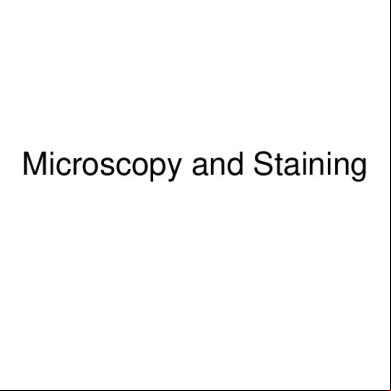Microscopy And Staining 12a5b
This document was ed by and they confirmed that they have the permission to share it. If you are author or own the copyright of this book, please report to us by using this report form. Report 2z6p3t
Overview 5o1f4z
& View Microscopy And Staining as PDF for free.
More details 6z3438
- Words: 752
- Pages: 27
Microscopy and Staining
Unit of Measure • Bacteria are VERY small, that’s why this is micro biology • The standard unit of measure in microbiology is the MICROMETER (µm) • A micrometer is 10-6 or .000001M • To see something this small you need to use a microscope and also color (stain) the cells to see them
Microscope • Because bacteria are so small a microscope is the essential tool in microbiology • Light microscope uses visible light to observe bacteria
Total Magnification Ocular (Eye Piece) 10X
Objective
Total Magnification
4X
40X
10X
10X
100X
10X
40X
400X
10X
100X (oil)
1000X
Resolution • Ability of the lens to distinguish fine detail • How close together can you distinguish two points as separate? • Because bacteria are so small good resolution is important • Resolution is DIRECTLY related to light in the following way: The SHORTER the wavelength of light the GREATER the resolution
More Resolution • To get the best resolution, use the SHORTEST wavelength of visible light that you can • Our microscopes use blue wavelength light to maximize resolution • Using blue light we can get a resolution of about .9 micrometers (µm)
Visible Spectrum
Spectrum • Average wavelength of visible light is .55µm • Red light wavelength is .68µm, violet light is .42µm, blue light is .48µm • Which light is best to use? The one with shortest wavelength • Using a shorter wavelength of light in the blue range give better resolution
Size Matters
Why Use Oil?
Smears and Staining • Bacteria must be stained (dyed) so they can be seen with the microscope • Before staining a smear must be made • A smear is just a film of bacteria on a glass slide • After the smear dries it is heat fixed, this – Kills the bacteria – Helps adhere the cells to the slide – Makes the cells more receptive to the dye
Stains • Stains are dyes • Stains carry either a positive charge (basic dyes) or a negative charge (acidic dyes) • Bacteria typically carry a slight negative charge on the cell surface so they attract a basic dye • Most of the stains used in the lab are basic dyes • A negative stain uses acidic dyes that do not stain the cell but rather the background
Staining - Increases Contrast Copyright © The McGraw-Hill Companies, Inc. Permission required for reproduction or display.
• Most microbes are… • Colorless • Very Small • Difficult to see • Staining increases contrast • Increases size sometimes
(a)
Simple Stains
Crystal violet stain of Escherichia coli
Methylene blue stain of Corynebacterium a1: © Kathy Park Talaro; a2: © Harold J. Benson
Staining
• Positive staining: the dye sticks to the specimen to give it color
Staining • Negative staining: The dye does not stick to the specimen, instead settles around its boundaries, creating a silhouette.
Staining Techniques • Simple Stain • Uses only one basic dye • Provides basic information about cell shape and arrangement
• Differential Stain • Uses more than one dye • These procedures react differently with different kinds of bacteria • Helps distinguish between different kinds of bacteria • Most common and important differential stain is the GRAM STAIN
Simple Stains • Require only a single dye – Examples include malachite green, crystal violet, basic fuchsin, and safranin – All cells appear the same color but can reveal shape, size, and arrangement
Differential Stains • Use two differently colored dyes, the primary dye and the counterstain – Distinguishes between cell types or parts – Examples include Gram, acid-fast, and endospore stains
Gram Staining • The most universal diagnostic staining technique for bacteria • Differentiation of microbes as gram positive (purple) or gram negative (red)
Gram Stain • Most important differential staining technique • Differentiates all bacteria based on cell wall composition • Bacteria are either Gram + and stain blue or Gram- and stain red • Gram stain is usually the first step in identifying an unknown bacteria
Gram Stain
Gram stain
Acid-Fast Staining • Important diagnostic stain • Differentiates acidfast bacteria (pink) from non-acid-fast bacteria (blue) • Important in medical microbiology – Mycobacterium
Endospore Stain • Dye is forced by heat into resistant bodies called spores or endospores • Distinguishes between the stores and the cells they come from (the vegetative cells) • Significant in medical microbiology
Special Stains • Used to emphasize certain cell parts that aren’t revealed by conventional staining methods • Examples: capsule staining, flagellar staining
Unit of Measure • Bacteria are VERY small, that’s why this is micro biology • The standard unit of measure in microbiology is the MICROMETER (µm) • A micrometer is 10-6 or .000001M • To see something this small you need to use a microscope and also color (stain) the cells to see them
Microscope • Because bacteria are so small a microscope is the essential tool in microbiology • Light microscope uses visible light to observe bacteria
Total Magnification Ocular (Eye Piece) 10X
Objective
Total Magnification
4X
40X
10X
10X
100X
10X
40X
400X
10X
100X (oil)
1000X
Resolution • Ability of the lens to distinguish fine detail • How close together can you distinguish two points as separate? • Because bacteria are so small good resolution is important • Resolution is DIRECTLY related to light in the following way: The SHORTER the wavelength of light the GREATER the resolution
More Resolution • To get the best resolution, use the SHORTEST wavelength of visible light that you can • Our microscopes use blue wavelength light to maximize resolution • Using blue light we can get a resolution of about .9 micrometers (µm)
Visible Spectrum
Spectrum • Average wavelength of visible light is .55µm • Red light wavelength is .68µm, violet light is .42µm, blue light is .48µm • Which light is best to use? The one with shortest wavelength • Using a shorter wavelength of light in the blue range give better resolution
Size Matters
Why Use Oil?
Smears and Staining • Bacteria must be stained (dyed) so they can be seen with the microscope • Before staining a smear must be made • A smear is just a film of bacteria on a glass slide • After the smear dries it is heat fixed, this – Kills the bacteria – Helps adhere the cells to the slide – Makes the cells more receptive to the dye
Stains • Stains are dyes • Stains carry either a positive charge (basic dyes) or a negative charge (acidic dyes) • Bacteria typically carry a slight negative charge on the cell surface so they attract a basic dye • Most of the stains used in the lab are basic dyes • A negative stain uses acidic dyes that do not stain the cell but rather the background
Staining - Increases Contrast Copyright © The McGraw-Hill Companies, Inc. Permission required for reproduction or display.
• Most microbes are… • Colorless • Very Small • Difficult to see • Staining increases contrast • Increases size sometimes
(a)
Simple Stains
Crystal violet stain of Escherichia coli
Methylene blue stain of Corynebacterium a1: © Kathy Park Talaro; a2: © Harold J. Benson
Staining
• Positive staining: the dye sticks to the specimen to give it color
Staining • Negative staining: The dye does not stick to the specimen, instead settles around its boundaries, creating a silhouette.
Staining Techniques • Simple Stain • Uses only one basic dye • Provides basic information about cell shape and arrangement
• Differential Stain • Uses more than one dye • These procedures react differently with different kinds of bacteria • Helps distinguish between different kinds of bacteria • Most common and important differential stain is the GRAM STAIN
Simple Stains • Require only a single dye – Examples include malachite green, crystal violet, basic fuchsin, and safranin – All cells appear the same color but can reveal shape, size, and arrangement
Differential Stains • Use two differently colored dyes, the primary dye and the counterstain – Distinguishes between cell types or parts – Examples include Gram, acid-fast, and endospore stains
Gram Staining • The most universal diagnostic staining technique for bacteria • Differentiation of microbes as gram positive (purple) or gram negative (red)
Gram Stain • Most important differential staining technique • Differentiates all bacteria based on cell wall composition • Bacteria are either Gram + and stain blue or Gram- and stain red • Gram stain is usually the first step in identifying an unknown bacteria
Gram Stain
Gram stain
Acid-Fast Staining • Important diagnostic stain • Differentiates acidfast bacteria (pink) from non-acid-fast bacteria (blue) • Important in medical microbiology – Mycobacterium
Endospore Stain • Dye is forced by heat into resistant bodies called spores or endospores • Distinguishes between the stores and the cells they come from (the vegetative cells) • Significant in medical microbiology
Special Stains • Used to emphasize certain cell parts that aren’t revealed by conventional staining methods • Examples: capsule staining, flagellar staining










